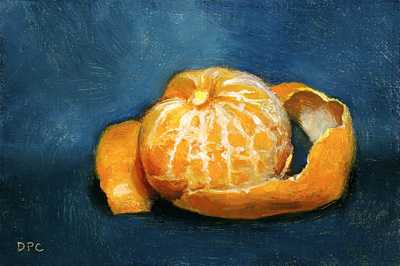
12/12. Clementine, oil on linen panel, 4x6 in.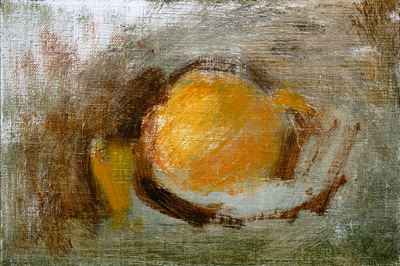
It seems as though everyone has painted a peeled clementine at one time or another so I thought I'd try as well. Again I photographed the very beginning stage and it shows how unpredictably I start to work sometimes - I was a little sad that I had to get much thicker with the paint.
I took a break last night from painting and instead wrote some of the thoughts I'd been having lately (after which I meant to post this piece but I didn't get that far). To the previous post I feel I should add that those "other" ideal qualities to strive for in painting were only the ones that came to mind the most easily to me. Also, in having the opinion that I do I might only keep myself from attaining the level of discipline needed to begin mastering those other qualities. Yet, I believe all of those things will just manifest themselves more and more with time, simply as a result of being productive and acting on inspiration, being viscerally receptive to paint's little accidents.
I must surely come off as offensive any time I suggest simply that some painters are a dead master's wannabes (I think they would easily outpaint me, as true wannabes have incredible discipline). Now couldn't someone say the same about me, based on everything I've said about Bonington? Yeah, maybe I'd give a body part or two to paint as well as he did, but if I suddenly could I still wouldn't reproduce his way of "seeing" and be attracted to the same things he was, composing pictures the way he did. Especially as I have my own quirks, as do most painters. And of course most aren't wannabes (and, like me, have wide ranging influences), yet there are so many who try real hard to turn into the next Sargent, say, and just become indistinguishable from all the rest. Well at least they employ a consistent "style," so who am I to say anything?...
Friday, December 14, 2007
Clementine
Posted by
Dan P. Carr
at
8:30 PM
4
comments
![]()
Tags: daily painting, food, miscellanea, work in progress
Onion #4

12/11. Onion #4, oil on linen panel, 4x4 in.
I attempted to paint roughly, scumbling and scratching a lot, to match the skin of this onion. It was dry and dirty in places and unappealing, but it seemed to radiate all these clean colors which I don't normally see in onions. The first bold mark I made was the transparent crimson edge at top, and once I put some green and purple around it it felt alive like a slippery koi in a pond.
This isn't the best painting nor the most instructive experiment, but in it are some interesting things. I've been thinking a lot lately about why I paint (and why I'm so glad to be painting again after so long) and what it is that's so interesting about doing little studies which don't deviate much in composition. Maybe this goes for most other oil painters who aren't concerned with the avant-garde (there's no such thing anymore), but for me it's simply got to be the nature of paint and the experience of color on the eyes, the almost musical play of pigment floating luminously next to, around, and beneath airy veils and dense tapestries of color. I wish I could describe it more eloquently. Although I wasn't yet ready for the journey at the time, perhaps I had decided years ago as Markowsky was encouraging us to exploit it in painting class - but especially when I first saw paintings by Bonington in a book - that my goal should be to find the balance between transparent and opaque. That's all.
By this I mean: not to dance around that point, emulating Velasquez, where at a certain viewing distance the image comes together and is no longer a chaos of disparate strokes. Nor strive for Rembrandt's light, or some "secret" process or medium of his - he had none, just skill and patience. Nor, as I've started to realize more and more, attempt to "transcribe" nature the way Liszt condensed Beethoven's giant symphonies to be played on a piano - though that's not a feat to laugh at. Sure, all of these things together are ideal, but I just want to be there when the little mysteries in the paint reveal themselves. Like when oil mimics watercolor and changes back again. Bonington made paint sing - his sketchy pieces still kill me after all these years (and I'll have to scan some pictures from a book next time to justify my obsession, since you can't find any good examples anywhere else). Sargent did it too - but I believe what I'm talking about isn't what his wannabes today are emulating (flashy brushstrokes that sculpt a face or a hand or the lapel of a jacket with as few notes as possible). Well ok, add that to the list of ideal things, as Bonington was a master of economy too.
But those things are all human things, the craft side of painting, like the way a chef puts the food in little stacks on a rectangular plate and drizzles the sauce over it in graceful zigzags. Or like the way a carpenter shapes the wood. Bad comparisons perhaps? Before constructing the joints or "plating" the food, there are the different woods, the ingredients of a dish, and their wondrous qualities. So, although I have a lot to learn about the craft of painting, what's always more interesting is what the paint does to me and not what I can do to it.
Posted by
Dan P. Carr
at
12:53 AM
1 comments
![]()
Tags: daily painting, food, miscellanea
Wednesday, December 12, 2007
Bunch of parsley
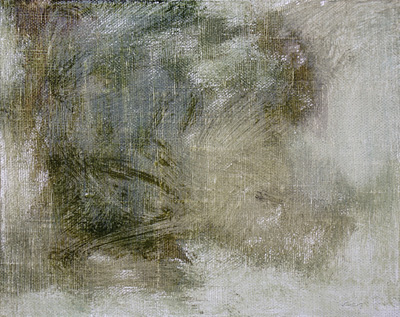
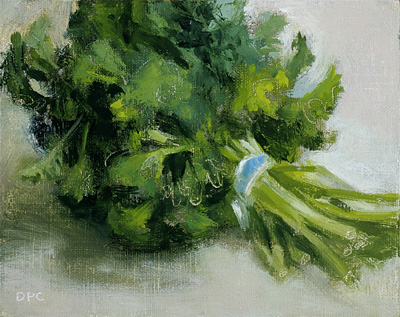
12/10. Bunch of parsley, oil on linen panel, 4x5 in.
I took the first photo when I realized I was working in a new way, that is I used a cool color to rough out the form (very rough) and stain the canvas - I don't know if it was simply because the dominant color here is green or if it was a subconscious experiment - but the surface seemed to have infinite potential once that amorphous shadow was sketched in. In some recent pieces I had thrown in some bluish-white at this early stage to get some of the "air" along the edges, though not here because the parsley isn't a solid form with a turning edge. In this case the blue went into the bulk of the parsley, more as an effect of the light than atmosphere. But I found as I went along that it was good to have the initial rough stage as a foundation, something to play off of for subtle space around the parsley. Normally I had used a brown all over for blocking in shadows etc., even in the broccoli piece, because I was so used to it.
(One of these days I might try something else novel, that is go to bed early so that I can think and write in the morning and am not like a zombie with a blog.)
Posted by
Dan P. Carr
at
6:24 PM
3
comments
![]()
Tags: daily painting, food, work in progress
Monday, December 10, 2007
Persimmon #2
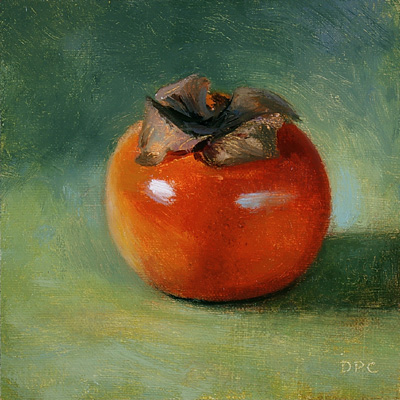
12/9. Persimmon #2, oil on linen panel, 4x4 in.
The leafy junk on top frustrates me, as I can't always tell what's going on with the forms and the colors are unusual. Overall this piece isn't as airy as yesterday's, but the persimmon color seems a little truer - I say seems because there is more of a dirty yellow in actuality, but I think I've made my color convincing.
Posted by
Dan P. Carr
at
6:03 PM
0
comments
![]()
Tags: daily painting, food
Sunday, December 9, 2007
Persimmon
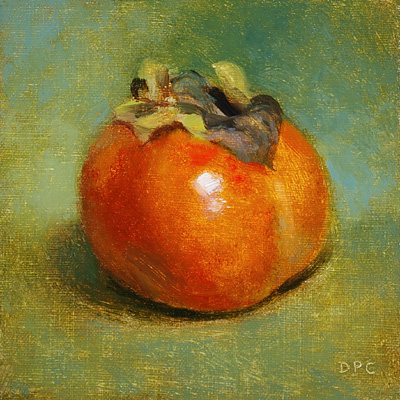
12/8. Persimmon, oil on linen panel, 4x4 in. SOLD
Why have I been repeating the title under each piece when it's already titled at the top? Who knows.... I think I've only ever tasted a persimmon when I was a kid. This one is of the Israeli "Sharon" variety, classified under the most common species (Diospyros kaki) that includes the widely grown Japanese "hachiya" and other types. A related persimmon variety is the Diospyros lotus, or "date-plum," which to the ancient Greeks was called the fruit of the gods, according to Wikipedia - Dios pyros, lit. "the wheat of Zeus" - and (this is one of several theories) it is the fruit mentioned in that brief scene of the Odyssey, in which Odysseus and his men
Odysseus "took these men back weeping, by force," to the ship and tied them up under the rowing benches before getting the heck out of there. (Then came the mess with the Cyclopes.) So my persimmon isn't this "lotus" type, but I found it all very interesting.landed in the country of the Lotus-Eaters, who live on a flowering food, and there we set foot on the mainland ... then I sent some of my companions ahead, telling them to find out what men, eaters of bread, might live here in this country.... My men went on and presently met the Lotus-Eaters ... But any of them who ate the honey-sweet fruit of lotus was unwilling to take any message back, or to go away, but they wanted to stay there with the lotus-eating people, feeding on lotus, and forget the way home. [Translated by Richmond Lattimore.]
Posted by
Dan P. Carr
at
5:35 PM
0
comments
![]()
Tags: books, daily painting, food, history, miscellanea, words


